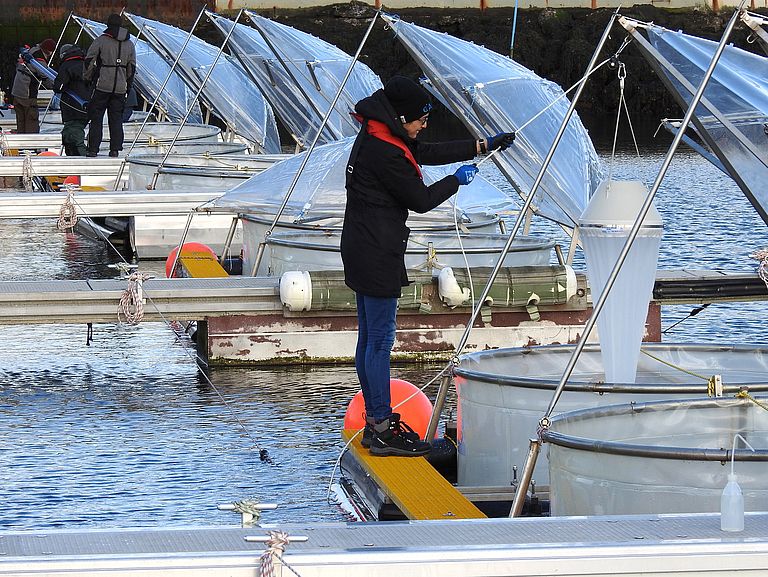Using slaked lime to fight climate change
An experiment on the island of Helgoland examines a potential solution for the long-term removal of carbon dioxide from the atmosphere with the help of the ocean
Even with a very ambitious climate policy supported and implemented by all states, humankind is still expected to emit ten to 20 per cent of current carbon dioxide emissions in three decades’ time, further advancing climate change. Nevertheless, in order to limit global warming and its impacts as laid down in the Paris Agreement, greenhouse gas emissions have to reach “net zero”. Net zero means achieving a balance between human-induced greenhouse gas emissions and greenhouse gases removed from the atmosphere and stored over the long term. This requires active carbon dioxide removal from the atmosphere, which compensates unavoidable residual emissions. The extent to which the ocean is able to support such approaches and what ecological risks might be associated with them is currently being investigated by a team of researchers in a study on the North Sea island of Helgoland. The study, funded by the Federal Ministry of Education and Research (Bundesministerium für Bildung und Forschung, BMBF), is part of the RETAKE consortium of the research mission “Marine carbon sinks in decarbonisation pathways” (CDRmare) of the German Marine Research Alliance (Deutsche Allianz Meeresforschung, DAM).
How much carbon dioxide (CO2) the ocean is able to absorb depends on the alkalinity of the seawater. This term refers to the amount of acid-binding mineral components that have previously been dissolved from weathered rock and carried into the sea. The weathering of rock is a natural process that removes carbon dioxide released into the atmosphere on geological time scales, for example through volcanic eruptions. While this process has kept the Earth's climate largely stable over the past billions of years, carbon dioxide input caused by humans is about a hundred times too fast to be compensated for by natural weathering. Accelerated weathering, for example through the introduction of such minerals into the surface layer of the ocean, can help increase its carbon dioxide uptake and long-term storage.
A crucial question regarding this approach that is also known as ocean alkalinisation: How can possible risks and negative side-effects to the marine ecosystems be avoided? This question is being investigated in the study that has just begun on Helgoland. For this purpose, the researchers have enclosed natural seawater with all the living organisms it contains in twelve mesocosms, each with a volume of 6,000 litres. Under near-natural environmental conditions, they simulate different scenarios of alkalinisation and investigate their effects on marine life.
“The study aims to determine the threshold of alkalinity increase below which this process is ecologically sound,” explains Professor Dr. Ulf Riebesell from GEOMAR Helmholtz Centre for Ocean Research Kiel, head of the study. These findings can help to identify the most suitable methods for applying the minerals. “In addition to the long-term storage of CO2, ocean alkalinisation has the positive side effect of counteracting ocean acidification,” adds Professor Dr. Maarten Boersma, Spokesperson of the Biology Department at Alfred Wegener Institute, Helmholtz Centre for Polar and Marine Research and one of the lead scientists in the RETAKE consortium.
The results of the study will be incorporated into an overarching assessment of all ocean-based approaches for active CO2 removal carried out as part of the research mission CDRmare. “The CDRmare mission brings together the expertise of scientists from the natural sciences, social and political sciences, ethics and the law of the sea,” explains Professor Dr. Andreas Oschlies, Earth system modeller at GEOMAR, coordinator of RETAKE and one of the speakers of CDRmare. “The results and assessments we obtain will help to provide a scientifically sound basis for decision-making on possible measures for active CO2 removal. Which measures will ultimately be taken to mitigate climate change must be decided in a process involving all societal sectors.”
Background: Marine carbon sinks in decarbonisation pathways (CDRmare):
In the research mission “Marine carbon sinks in decarbonisation pathways” (CDRmare) of the German Marine Research Alliance (Deutsche Allianz Meeresforschung, DAM), about 200 researchers in six collaborative projects investigate in which way and to what extent the ocean can play a sustainable role in the removal and storage of carbon dioxide from the atmosphere. The long-term goal is to develop a roadmap for the active use of marine carbon reservoirs that will help limit the consequences of human-induced climate change and observe the limits of the Paris climate goals. CDRmare (CDR = Carbon Dioxide Removal) is coordinated at GEOMAR Helmholtz Centre for Ocean Research Kiel and the Leibniz Institute for Baltic Sea Research Warnemünde. The Federal Ministry of Education and Research is funding the research mission with 26 million Euros over an initial phase of three years (1.8.2021 to 31.7.2024).

In an experiment at the North Sea island of Helgoland, researchers of the joint project RETAKE of the research mission CDRmare investigate possible risks and negative side effects of ocean alkalinisation. Photo: Ulf Riebesell, GEOMAR

The mesocosms form an experimental world, closed off from the outside for experiments under close-to-natural environmental conditions. Photo: Michael Sswat,

With the help of regular sampling and measurements, the researchers investigate whether the ocean can absorb more carbon dioxide (CO2) from the atmosphere through the addition of slaked lime and what influence this has on plankton communities in the sea. Photo: Ulf Riebesell, GEOMAR

In mesocosms - floating experimental facilities closed off from the outside - accelerated weathering is simulated by adding minerals. Photo: Michael Sswat, GEOMAR


